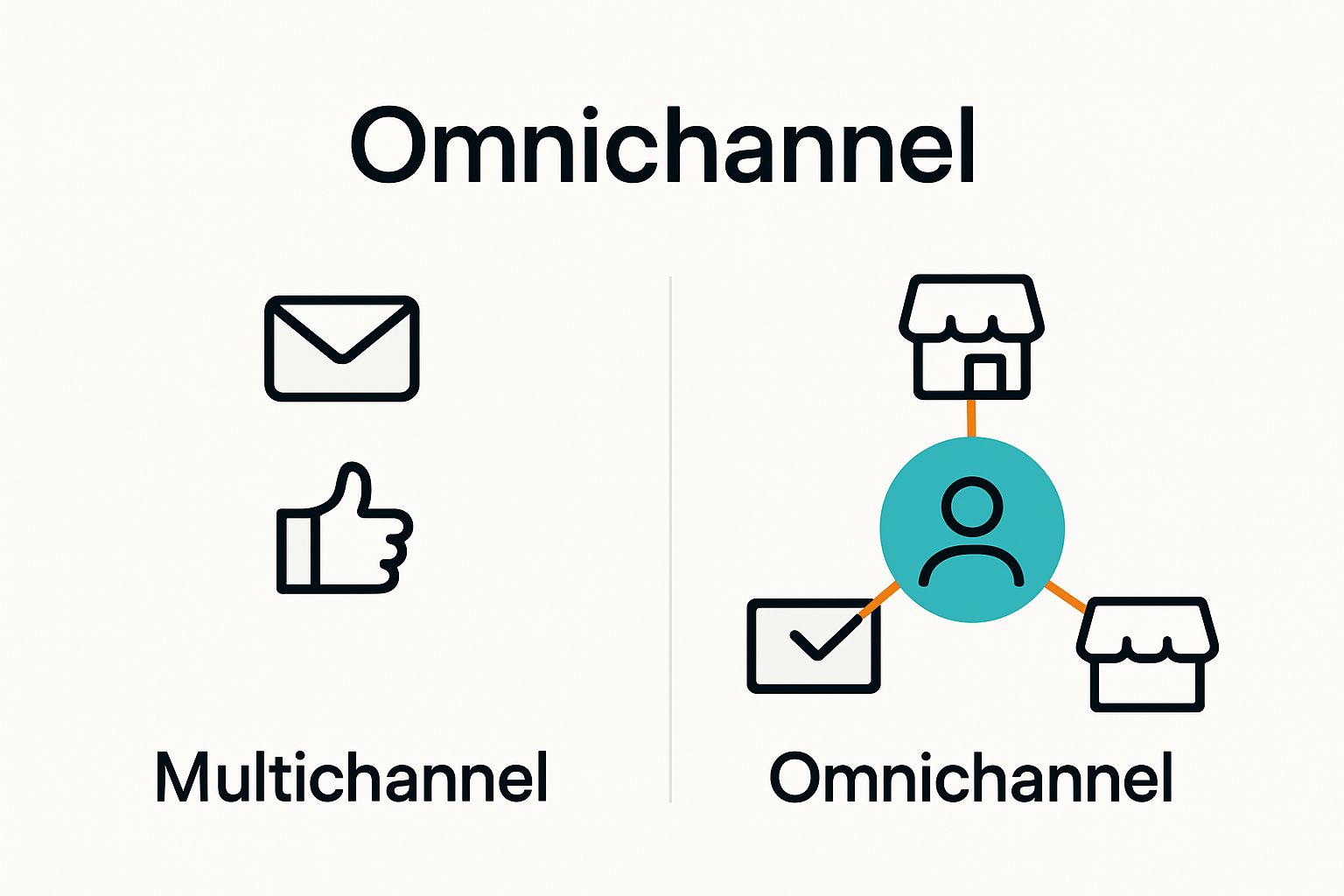What is Omnichannel Marketing? Understanding Its Importance
Omnichannel marketing is changing the way brands connect with people everywhere. Most businesses think having a website and a few social media pages is enough. But brands that master omnichannel strategies have customers who spend 30 percent more per purchase compared to those using just one channel. That kind of difference flips the entire playbook for reaching and keeping loyal shoppers.
Table of Contents
- What Is Omnichannel Marketing? A Comprehensive Definition
- The Importance Of Omnichannel Marketing For Brands
- Key Principles Of Effective Omnichannel Marketing Strategies
- How Omnichannel Marketing Enhances Customer Experience
- Real-World Examples Of Successful Omnichannel Marketing
Quick Summary
| Takeaway | Explanation |
|---|---|
| Omnichannel marketing creates seamless customer experiences. | It integrates various channels to ensure consistent customer interactions regardless of the platform used. |
| Understand customer journeys for personalized marketing. | Comprehensive data analysis helps brands tailor experiences to individual customer preferences across all touchpoints. |
| Invest in technology for real-time data synchronization. | Robust CRM systems and analytics are essential for maintaining a unified view of customer interactions. |
| Enhanced engagement leads to increased customer loyalty. | Multi-channel interactions significantly boost customer lifetime value and retention rates compared to single-channel engagement. |
| Keep messaging consistent across all platforms. | Consistent communication strengthens brand identity and helps customers feel recognized, improving overall satisfaction. |
What is Omnichannel Marketing? A Comprehensive Definition
Omnichannel marketing represents a strategic approach that creates a seamless, integrated customer experience across multiple channels and touchpoints. Unlike traditional multichannel marketing, omnichannel marketing focuses on delivering a consistent, personalized interaction regardless of how or where a customer engages with a brand.
The table below compares the key differences between multichannel and omnichannel marketing as discussed in the article to clarify their distinct approaches.
| Concept | Multichannel Marketing | Omnichannel Marketing |
|---|---|---|
| Strategy Focus | Presence on multiple channels | Seamless integration across all channels |
| Customer Experience | Varies by channel; not always consistent | Unified, consistent journey across platforms |
| Data Integration | Often isolated; siloed data | Centralized, synced customer data |
| Personalization | Limited, channel-specific | Hyper-personalized, cross-channel |
| Message Consistency | May differ between platforms | Consistent across every touchpoint |

The Core Philosophy of Unified Customer Experience
At its essence, omnichannel marketing recognizes that modern consumers move fluidly between digital and physical platforms. A customer might start researching a product on a mobile app, continue browsing on a desktop website, and complete the purchase in a physical store. The key is ensuring these interactions feel connected and coherent.
The fundamental goal of omnichannel marketing is to break down silos between different communication channels, creating a unified brand experience. This means your messaging, design, and customer service remain consistent whether a customer interacts through:
- Social media platforms
- Email communications
- Mobile applications
- Physical retail locations
- Website interactions
- Customer support channels
Technical Infrastructure and Customer Data Integration
Successful omnichannel marketing requires sophisticated technological infrastructure that enables real-time data synchronization. According to Deloitte’s Digital Marketing Report, brands must invest in robust customer relationship management (CRM) systems and analytics platforms that track customer interactions across multiple touchpoints.
This table highlights essential technologies and their roles in supporting a successful omnichannel marketing strategy as described in the article.
| Technology | Role in Omnichannel Marketing |
|---|---|
| CRM Systems | Centralize and synchronize customer data in real time |
| Analytics Platforms | Track, monitor, and analyze customer interactions |
| Predictive Modeling Tools | Anticipate customer behavior for proactive engagement |
| Marketing Automation | Automate personalized messaging across channels |
| Integration Middleware | Connect different marketing, sales, and support systems |
This integrated approach allows businesses to create personalized experiences driven by comprehensive customer insights. By understanding a customer’s complete journey, brands can deliver more relevant, timely, and contextual marketing messages that resonate with individual preferences and behaviors. Learn more about our approach to marketing automation to understand how technology enables these sophisticated marketing strategies.
The Importance of Omnichannel Marketing for Brands
Omnichannel marketing has transformed from a strategic advantage to a critical business necessity in today’s hyperconnected digital ecosystem. Brands that successfully implement omnichannel strategies can dramatically improve customer engagement, loyalty, and overall revenue performance.
Enhanced Customer Experience and Retention
Customers now expect seamless, personalized interactions across every touchpoint. According to Harvard Business Review, customers who engage with brands through multiple channels are significantly more valuable. These customers spend 30% more per purchase and demonstrate higher long-term loyalty compared to single-channel consumers.
The key benefits of omnichannel marketing include:
- Consistent brand messaging across platforms
- Personalized customer journey experiences
- Increased customer lifetime value
- Improved customer satisfaction and retention rates
- Enhanced data collection and customer insights
Competitive Advantage and Business Performance
Modern consumers are digital natives who evaluate brands based on their ability to provide smooth, integrated experiences. McKinsey Research indicates that companies with robust omnichannel strategies achieve 10% year-over-year growth and can potentially increase marketing effectiveness by up to 20%.
By understanding the nuances of brand positioning, brands can leverage omnichannel marketing to create more compelling, cohesive narratives that resonate across different customer touchpoints. This approach not only improves immediate sales but also builds long-term brand equity and customer trust.
Key Principles of Effective Omnichannel Marketing Strategies
Developing a successful omnichannel marketing strategy requires a holistic approach that goes beyond simply being present on multiple platforms. It demands a sophisticated understanding of customer behavior, technological integration, and strategic alignment across an organization.
Customer-Centric Data Integration
The foundation of effective omnichannel marketing lies in comprehensive customer data collection and intelligent analysis. According to Gartner’s Marketing Technology Research, brands must create a unified customer profile that tracks interactions across all touchpoints.
Key components of robust data integration include:
- Real-time data synchronization
- Cross-platform behavior tracking
- Predictive customer behavior modeling
- Comprehensive privacy and consent management
- Seamless integration between marketing, sales, and customer service systems
Personalization and Contextual Relevance
True omnichannel marketing transcends generic messaging by delivering hyper-personalized experiences. Adobe’s Digital Trends Report reveals that top-performing companies are 1.6 times more likely to prioritize personalization across customer journeys.
This means understanding not just who your customers are, but anticipating their needs, preferences, and potential friction points across different channels. Learn more about essential ecommerce marketing strategies to complement your omnichannel approach and create more nuanced customer experiences.
Successful omnichannel strategies require continuous iteration, technological adaptability, and a commitment to understanding evolving customer expectations. By treating each interaction as part of a larger, interconnected customer journey, brands can create more meaningful, responsive marketing ecosystems.
How Omnichannel Marketing Enhances Customer Experience
Omnichannel marketing transforms customer experience by creating a fluid, interconnected journey that anticipates and responds to individual preferences across multiple platforms. This approach goes beyond traditional marketing by treating each customer interaction as a continuous, personalized conversation.
Seamless Interaction and Contextual Continuity
Customers today expect brands to remember their preferences and previous interactions, regardless of the channel they choose. According to Salesforce Research, 73% of customers expect companies to understand their unique needs and expectations across every touchpoint.
Key elements of enhanced customer experience include:
- Consistent messaging and brand identity
- Smooth transition between digital and physical channels
- Immediate recognition of customer history
- Personalized recommendations based on past interactions
- Reduced friction in customer journey
Predictive Customer Engagement
Advanced omnichannel strategies leverage artificial intelligence and machine learning to predict and proactively address customer needs. Forrester’s Customer Experience Index demonstrates that brands delivering exceptional, predictive experiences see significant improvements in customer loyalty and revenue.
By understanding marketing automation basics, brands can create intelligent systems that not only respond to customer actions but anticipate their future requirements. This predictive approach transforms customer experience from reactive service to proactive engagement, building deeper connections and trust.

Real-World Examples of Successful Omnichannel Marketing
Some of the most innovative brands have transformed customer experiences by implementing sophisticated omnichannel marketing strategies that blur the lines between digital and physical interactions. These examples demonstrate how comprehensive, integrated approaches can dramatically enhance customer engagement and loyalty.
Retail and Technology Integration
Apple stands out as a quintessential omnichannel marketing leader. Their strategy seamlessly connects online browsing, in-store experiences, mobile applications, and customer support. According to Harvard Business Review, customers can start product research online, schedule in-store appointments, receive personalized recommendations, and access support through multiple channels without losing context.
Key aspects of successful omnichannel implementation include:
- Consistent brand experience across platforms
- Integrated customer data management
- Seamless transition between digital and physical touchpoints
- Real-time inventory and service synchronization
- Personalized customer journey tracking
Innovative Customer Experience Strategies
Starbucks provides another compelling example of omnichannel excellence. Their mobile application integrates payment systems, loyalty programs, personalized ordering, and location-based services. McKinsey’s Digital Transformation Research highlights how such integrated approaches can increase customer lifetime value and create more engaging brand interactions.
Understanding audience segmentation becomes crucial in developing these nuanced, personalized omnichannel strategies. By recognizing individual customer preferences and creating tailored experiences, brands can transform traditional marketing approaches into dynamic, responsive customer engagement ecosystems.
Turn Omnichannel Strategy Into Measurable Growth
Are you struggling to deliver the seamless, integrated customer experience that modern shoppers expect? The article highlighted the real challenges brands face today, from disconnected customer journeys to inconsistent messaging and low retention rates. You want your email channel to fully support your omnichannel vision, but unifying your data, automation, and personalization often feels overwhelming.

Take the next step toward real results. See how Take Action helps ecommerce brands align powerful email automation with proven segmentation and strategic campaigns. Move beyond theory with personalized flows like welcome series, abandoned cart recovery, and data-driven retention programs, all designed to create a consistent customer experience across every channel. Start optimizing your email channel for real engagement and revenue today. Visit our homepage to get started or learn more about our advanced marketing automation solutions tailored for ambitious brands. Achieve seamless connections and sustained growth now.
Frequently Asked Questions
What is the main goal of omnichannel marketing?
The main goal of omnichannel marketing is to create a seamless and unified customer experience across multiple channels. To implement this, focus on breaking down communication silos between digital and physical channels to provide consistent messaging.
How can businesses enhance customer experience through omnichannel marketing?
Businesses can enhance customer experience by ensuring consistent brand messaging and personalized interactions across all touchpoints. Start by gathering customer data and implementing real-time updates to track interactions, which helps create a more cohesive journey.
What technologies are essential for successful omnichannel marketing?
Successful omnichannel marketing relies on advanced technologies such as CRM systems for customer data management and analytics platforms for monitoring interactions. Invest in these technologies to synchronize customer insights and improve personalization.
How does omnichannel marketing impact customer retention?
Omnichannel marketing positively impacts customer retention by creating personalized and fluid interactions that lead to higher satisfaction. Aim to track customer preferences and interactions; brands that do so often see a significant increase in customer loyalty and lifetime value.
What steps should I take to implement an omnichannel strategy?
To implement an omnichannel strategy, begin by analyzing existing touchpoints and integrating customer data across all channels. Set clear goals for brand messaging consistency and improve personalization, ideally within the first 30–60 days, to see noticeable benefits.
Why is personalization important in omnichannel marketing?
Personalization is crucial in omnichannel marketing as it allows businesses to tailor experiences to individual customer needs, enhancing engagement. To achieve this, collect customer behavior data across platforms and create targeted marketing campaigns based on their preferences.
Recommended
- Understanding Marketing Automation Explained Simply | Take Action Blog | Take Action
- Understanding the Importance of Marketing Analytics | Take Action Blog | Take Action
- Mastering Brand Positioning Strategies for Ecommerce Success | Take Action Blog | Take Action
- Understanding Marketing Automation Basics for Brands | Take Action Blog | Take Action
- What is Digital Marketing? Understanding Its Importance
- What is Multimedia Marketing? Understanding Its Power
